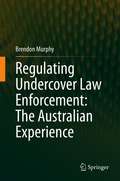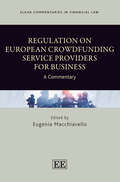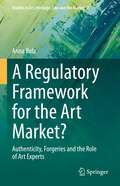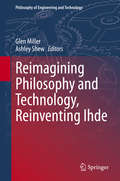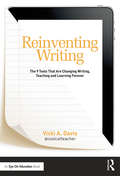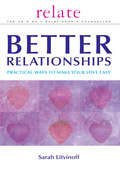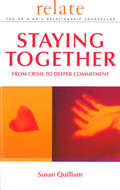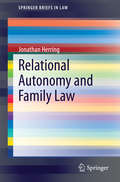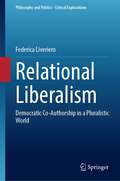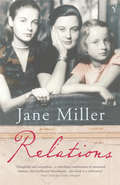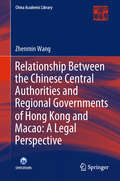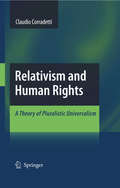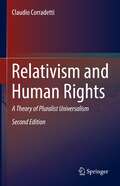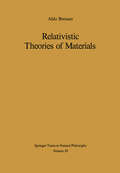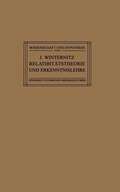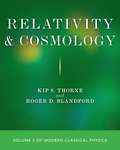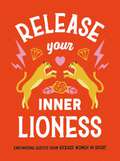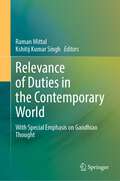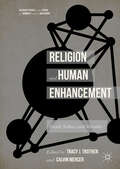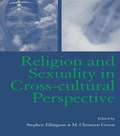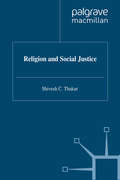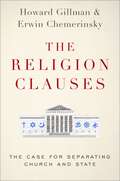- Table View
- List View
Regulating Undercover Law Enforcement: The Australian Experience
by Brendon MurphyThis book examines the way in which undercover police investigation has come to be regulated in Australia. Drawing on documentary and doctrinal legal analysis, this book investigates how, in the space of a single decade, Australian law makers set out to regulate one of the most difficult aspects of police: undercover investigation. In so doing, the Australian experience represents a paradigm model. And yet despite its success, it is a system of law and practice that has a dark side – a model of investigation to relies heavily on activities that are unlawful in the absence of authorisation. It is a model that is as much concerned with the surveillance and control of police as it is with suspected criminal conduct.The book aims to locate the Australian experience in comparative perspective with other major common law jurisdictions (the United Kingdom, Canada and New Zealand), with a view to contrast strengths, similarities and weaknesses of these models. It is argued that the Australian model, at the pragmatic level, offers a highly successful model for regulatory structure and practice, providing a significant model for successful regulation. At the same time, the model that has been introduced raises important questions about how and why the Australian experience evolved in the way that it did, and the implications this has for the relationship between citizen and state, the judiciary and the executive, and broader questions about the protections offered by rights discourse and jurisprudence. This book aims to document the law, policy and practices that shape undercover investigations. In so doing, it aims to not only articulate the way in which the law regulates these activities, but also to move on to consider some of the fundamental questions linked to undercover investigations: how did regulation happen? By what means of regulation? What are the driving policy issues that give this field of law its particular complexion? What are the implications? Who gains, and who loses, by which means of power?The book offers unique insights into a largely unknown aspect of modern covert policing, identifying a range of practices, the legal framework, controversies and powers. By locating these practices in a rich theoretical context, informed by risk and governmentality scholarship, this book offers a legal and theoretical explanation of one of the most controversial forms of policing.
Regulation on European Crowdfunding Service Providers for Business: A Commentary (Elgar Commentaries in Financial Law series)
This innovative Commentary boasts contributions from internationally renowned experts with extensive and diverse backgrounds, providing a comprehensive, critical, article-by-article and thematic analysis of the EU Regulation No 1503/2020 on European Crowdfunding Service Providers for Business (ECSPR). Chapters analyse Member States’ adaptation of their legal frameworks to the ECSPR, underlying similarities, divergences, additional problematic issues and residual regulatory fragmentation.Key Features:A theoretical and cross-sectoral approach to crowdfunding services and relative regulationsConstant comparison of ECSPR’s provisions with other similar or interrelated EU frameworksAn article-by-article and thematic analysis of the ECSPR, underlying its strengths, innovative characters and problematic aspectsAnalysis of the implementation of the ECSPR in different countries and adaptation of their legal frameworks, including France, Germany, Italy, Portugal, Spain, the Netherlands, Nordic countries and the Baltics The Commentary is a fundamental companion to the interpretation and application of the ECSPR which will appeal to a diverse range of readers. Academics, scholars, practitioners and professionals interested in financial regulation, EU law, technology law, business law, law of contracts, competition law, international law and comparative law will find this a beneficial resource.
A Regulatory Framework for the Art Market?: Authenticity, Forgeries and the Role of Art Experts (Studies in Art, Heritage, Law and the Market #7)
by Anna BolzThis book addresses practical issues in connoisseurship and authentication, as well as the legal implications that arise when an artwork’s authenticity is challenged. In addition, the standards and processes of authentication are critically examined and the legal complications which can inhibit the expression of expert opinions are discussed. The notion of authenticity has always commanded the attention of art market participants and the general art-minded public alike. Coinciding with this, forgery is often considered to be the world’s most glamorous crime, packed with detective stories that are usually astonishing and often bizarre. The research includes findings by economists, sociologists, art historians, lawyers, academics and practitioners, all of which yield insights into the mechanics and peculiarities of the art business and explain why it works so differently from other markets. However, this book will be of interest not only to academics, but to everyone interested in questions of authenticity, forgery and connoisseurship. At the same time, one of its main aims is to advocate best practices in the art market and to stress the importance of cooperation among all disciplines with a stake in it. The results are intended to offer guidance to art market stakeholders, legal practitioners and art historians alike, while also promoting mutual understanding and cooperation.
Reimagining Philosophy and Technology, Reinventing Ihde (Philosophy of Engineering and Technology #33)
by Ashley Shew Glen MillerThis volume includes eleven original essays that explore and expand on the work of Don Ihde, bookended by two chapters by Ihde himself. Ihde, the recipient of the first Society for Philosophy and Technology's Lifetime Achievement Award in 2017, is best known for his development of postphenomenology, a blend of pragmatism and phenomenology that incorporates insights into the ways technology mediates human perception and action.The book contains contributions from academics from Europe, North America, and Asia, which demonstrates the global impact of Ihde’s work. Essays in the book explore the relationship between Ihde's work and its origins in phenomenology (especially Husserl and Heidegger) and American pragmatism; integrate his philosophical work within the embodied experience of radical architecture and imagine the possibility of a future philosophy of technology after postphenomenology;develop central ideas of postphenomenology and expand the resources present in postphenomenology to ethics and politics; andextend the influence of Ihde's ideas to mobile media and engineering, and comprehensively assess the influence of his work in China. The book includes a reprint of the Introduction of Sense and Significance, one of Ihde's first books; "Hawk: Predatory Vision," a new chapter that blends his biographical experience with feminism, technoscience, and environmental observation; and an appendix that lists all of Ihde's books as well as secondary sources annotated by Ihde himself. Starting with an Editors' Introduction that offers an overview of the central ideas in Ihde's corpus and concluding with an index that facilitates research across the various chapters, this book is of interest to a diverse academic community that includes philosophers, STM scholars, anthropologists, historians, and sociologists.
Reinventing Writing: The 9 Tools That Are Changing Writing, Teaching, and Learning Forever
by Vicki DavisIn this much-anticipated book from acclaimed blogger Vicki Davis (Cool Cat Teacher), you’ll learn the key shifts in writing instruction necessary to move students forward in today’s world. Vicki describes how the elements of traditional writing are being reinvented with cloud-based tools. Instead of paper, note taking, filing cabinets, word processors, and group reports, we now have tools like ePaper, eBooks, social bookmarking, cloud syncing, infographics, and more. Vicki shows you how to select the right tool, set it up quickly, and prevent common mistakes. She also helps you teach digital citizenship and offers exciting ways to build writing communities where students love to learn. Special Features:• Essential questions at the start of each chapter to get you thinking about the big ideas• A chapter on each of the nine essential cloud-based tools--ePaper and eBooks; digital notebooks; social bookmarking; cloud syncing; cloud writing apps; blogging and microblogging; wikis and website builders; online graphic organizers and mind maps; and cartoons and infographics• A wide variety of practical ways to use each tool in the classroom• Alignments to the Common Core State Standards in writing • Level Up Learning--a special section at the end of each chapter to help you review, reflect on, and apply what you’ve learned• Writing tips to help you make the best use of the tools and avoid common pitfalls• A glossary of key terms discussed in the book• Useful appendices, including reproducible material for your classroom No matter what grade level you teach or how much tech experience you have, you will benefit from Vicki’s compelling and practical ideas. As she emphasizes throughout this essential book, teaching with cloud-based tools has never been easier, more convenient, or more important than right now.
Reinventing Writing: The 9 Tools That Are Changing Writing, Teaching, and Learning Forever
by Vicki DavisIn this much-anticipated book from acclaimed blogger Vicki Davis (Cool Cat Teacher), you’ll learn the key shifts in writing instruction necessary to move students forward in today’s world. Vicki describes how the elements of traditional writing are being reinvented with cloud-based tools. Instead of paper, note taking, filing cabinets, word processors, and group reports, we now have tools like ePaper, eBooks, social bookmarking, cloud syncing, infographics, and more. Vicki shows you how to select the right tool, set it up quickly, and prevent common mistakes. She also helps you teach digital citizenship and offers exciting ways to build writing communities where students love to learn. Special Features:• Essential questions at the start of each chapter to get you thinking about the big ideas• A chapter on each of the nine essential cloud-based tools--ePaper and eBooks; digital notebooks; social bookmarking; cloud syncing; cloud writing apps; blogging and microblogging; wikis and website builders; online graphic organizers and mind maps; and cartoons and infographics• A wide variety of practical ways to use each tool in the classroom• Alignments to the Common Core State Standards in writing • Level Up Learning--a special section at the end of each chapter to help you review, reflect on, and apply what you’ve learned• Writing tips to help you make the best use of the tools and avoid common pitfalls• A glossary of key terms discussed in the book• Useful appendices, including reproducible material for your classroom No matter what grade level you teach or how much tech experience you have, you will benefit from Vicki’s compelling and practical ideas. As she emphasizes throughout this essential book, teaching with cloud-based tools has never been easier, more convenient, or more important than right now.
The Relate Guide to Better Relationships: Practical Ways to Make Your Love Last from the Experts in Marriage Guidance (Relate Relationships Ser.)
by Sarah Litvinoff'When I fall in love it will be forever...' or so goes the song. The reality can be different and the truth is that the nature of relationships will change over time. Few things can be more distressing than finding that you and your partner are no longer communicating the way you used to, that problems have developed, or that your relationship seems to have broken down. With 60 years cumulative experience of marriage guidance, the experts at Relate know better than most how to overcome relationship difficulties and in so doing create a strong, long-lasting partnership. This highly practical guide is packed full of relationship advice, exercises and guidelines to help you better understand yourself and your partner: - discover what makes your partner tick - test your compatibility - learn how to talk, listen and hear what each other is saying - improve your sex life - deepen your love through tackling problems together.
Relate Guide To Staying Together: From Crisis to Deeper Commitment (Relate Guides Ser.)
by Relate Susan QuilliamPacked with relationship advice from Relate, the marriage guidance experts, Staying Together offers guidelines to help couples survive and grow through their relationship problems so that they need not separate and may maintain their commitment to each other. Case histories, quizzes and questionnaires show how this is possible and even how to make a partnership stronger. The book covers how to: --confront difficulties --understand your partner --re-negotiate an improved relationship --develop skills to make improvements last --assess when problems first appeared and how they developed --face changes --communicate and meet a partner's needs --create good times --build on commitment and happiness.
Relational Autonomy and Family Law (SpringerBriefs in Law)
by Jonathan HerringThis book explores the importance of autonomy in family law. It argues that traditional understandings of autonomy are inappropriate in the family law context and instead recommends the use of relational autonomy. The book starts by explaining how autonomy has historically been understood, before exploring the problems with its use in family law. It then sets out the model of relational autonomy which, it will be argued, is more appropriate in this context. Finally, some examples of practical application are presented. The issues raised and theoretical discussion is relevant to any jurisdiction.
Relational Liberalism: Democratic Co-Authorship in a Pluralistic World (Philosophy and Politics - Critical Explorations #24)
by Federica LiverieroThis book investigates the unresolved issue of democratic legitimacy in contexts of pervasive disagreement and contributes to this debate by defending a relational version of political liberalism that rests on the ideal of co-authorship. According to this proposal, democratic legitimacy depends upon establishing appropriate interactions among citizens who ought to ascribe to one another the status of putative practical and epistemic authorities. To support this relational reading of political liberalism, the book proposes a revised account of the civic virtue of reasonableness along with an investigation of the epistemic-specific dimension of political equality. By engaging with political epistemology and social theory, this book explores ways to address inherent tensions within the liberal paradigm, using the following strategies of addressing these tensions: first, it defends a twofold model of legitimacy that distinguishes the goals, methodologies, and justificatory tasks of both ideal and nonideal phases of the two-level justificatory framework; second, it contends that democratic legitimacy requires an engaged and contextual critical appraisal of the injustices that characterize our daily social lives, illustrating how structural forms of injustice represent a profound betrayal of the liberal ideal of democratic legitimacy.
Relations: Sisters Brothers And Others (Women and Gender in the Early Modern World)
by Jane MillerIn this remarkable book, Jane Miller writes about the experience of being a daughter and a sister, about the intensities of family life and the illuminations that come from the last days of parents. Relations describes a record-keeping kinship and offers portraits of her parents' long marriage, its mysteries and incompatibilities, of her grandfather, the scientist Redcliffe Salaman, and of her great-aunt Clara Collet, one of the first women civil servants. It is a story in which Karl Marx and George Gissing have parts to play.Here are the tensions of belonging and yet not belonging to an English middle-class at once hospitable to difference and internally divided. More than two hundred years of English history are present in these portraits, which show the dawning emancipation of women and the effects of empire on family life. It is the story of an evolution, of a move out of trade towards public service and the professions, and towards the dramas and family romance of recent times.
Relationship Between the Chinese Central Authorities and Regional Governments of Hong Kong and Macao: A Legal Perspective (China Academic Library)
by Zhenmin WangThis book discusses the basic theories and structures employed in handling the Central-SAR relationship under the “One Country, Two Systems” policy from the perspective of ruling by law. It also explores the fundamental principles and methods used in the division of powers between the central authorities and the SARs, and investigates the institutions responsible for handling the Central-SAR relationship and their practices. Further, it presents case studies since 1997 to help readers better understand the Central-SAR relationship. Lastly, the author raises some new questions for readers who want to further study this topic.
Relativism and Human Rights: A Theory of Pluralistic Universalism
by Claudio CorradettiWhen he nished writing, he raised his eyes and looked at me. From that day I have thought about Doktor Pannwitz many times and in many ways. I have asked myself how he really functioned as a man; how he lled his time, outside of the Polymerization and the Indo- Germanic conscience; above all when I was once more a free man, I wanted to meet him again, not from a spirit of revenge, but merely from a personal curiosity about the human soul. Because that look was not one between two men; and if I had known how completely to explain the nature of that look, which came as if across the glass window of an aquarium between two beings who live in different worlds, I would also have explained the essence of the great insanity of the third Germany. PRIMO LEVI [If this is a man, pp. 111–112, in, If this is a man and The truce, trans. S. Woolf, Abacus, London, 1987] If all propositions, even the contingent ones, are resolved into identical propositions, are they not all necessary? My answer is: certainly not. For even if it is certain that what is more perfect is what will exist, the less perfect is nevertheless still possible. In propositions of fact, existence is involved. LEIBNIZ [Samtlic ¨ he schriften und briefe vol VI pt 4 Deutsche Akademie der Wissenschaften, 1449A VI 4] We live in a rule-constrained world.
Relativism and Human Rights: A Theory of Pluralist Universalism
by Claudio CorradettiThis is an innovative contribution to the philosophy of human rights. Considering both legal and philosophical scholarship, the views here bear an importance on the legitimacy of international politics and international law. As a result of more than 10 years of research, this revised edition engages with current debates through the help of new sections. Pluralistic universalism considers that, while formal filtering criteria constitute unavoidable requirements for the production of potentially valid arguments, the exemplarity of judgmental activity, in its turn, provides a pluralistic and retrospective reinterpretation for the fixity of such criteria. While speech formal standards grounds the thinnest possible presuppositions we can make as humans, the discursive exemplarity of judgments defends a notion of validity which is both contextually dependent and "subjectively universal". According to this approach, human rights principles are embedded within our linguistic argumentative practice. It is precisely from the intersubjective and dialogical relation among speakers that we come to reflect upon those same conditions of validity of our arguments. Once translated into national and regional constitutional norms, the discursive validity of exemplar judgments postulates the philosophical necessity for an ideal of legal-constitutional pluralism, challenging all those attempts trying to frustrate both horizontal (state to state) and vertical (supra-national-state-social) on-going debates on human rights.On the first edition of this book: “Claudio Corradetti’s book is a thoughtful attempt to find an adequate theoretical foundation for human rights. Its approach is interdisciplinary in nature, drawing on issues in analytical philosophy as well as contemporary political theorists, and the result is a densely argued text aimed at scholars … .” (Andrew Lambert, Metapsychology Online Reviews, Vol. 14 (3), January, 2010)
Relativistic Theories of Materials (Springer Tracts in Natural Philosophy #29)
by A. BressanThe theory of relativity was created in 1905 to solve a problem concerning electromagnetic fields. That solution was reached by means of profound changes in fundamental concepts and ideas that considerably affected the whole of physics. Moreover, when Einstein took gravitation into account, he was forced to develop radical changes also in our space-time concepts (1916). Relativistic works on heat, thermodynamics, and elasticity appeared as early as 1911. However, general theories having a thermodynamic basis, including heat conduction and constitutive equations, did not appear in general relativity until about 1955 for fluids and appeared only after 1960 for elastic or more general finitely deformed materials. These theories dealt with materials with memory, and in this connection some relativistic versions of the principle of material indifference were considered. Even more recently, relativistic theories incorporating finite deformations for polarizable and magnetizable materials and those in which couple stresses are considered have been formulated. A broader description of the development of these relativistic topics is contained in § 13. The purpose of this book is to describe the foundations of the general relativistic theories that include constitutive equations, and to present some applications, mainly to elastic waves, of these theories. This tract is divided into two parts. In the first part only the Eulerian point of view is considered; basic equations of general relativity, other than constitutive equations, are stated in full generality (except for couple stresses which are considered in part 2). Part 1 also thoroughly covers fluids, including constitutive equations.
Relativitätstheorie und Erkenntnislehre: Eine Untersuchung über die Erkenntnistheoretischen Grundlagen der Einsteinschen Theorie und die Bedeutung Ihrer Ergebnisse für die Allgemeinen Probleme des Naturerkennens (Wissenschaft und Hypothese #23)
by Dr. Josef WinternitzDieser Buchtitel ist Teil des Digitalisierungsprojekts Springer Book Archives mit Publikationen, die seit den Anfängen des Verlags von 1842 erschienen sind. Der Verlag stellt mit diesem Archiv Quellen für die historische wie auch die disziplingeschichtliche Forschung zur Verfügung, die jeweils im historischen Kontext betrachtet werden müssen. Dieser Titel erschien in der Zeit vor 1945 und wird daher in seiner zeittypischen politisch-ideologischen Ausrichtung vom Verlag nicht beworben.
Relativity and Cosmology: Volume 5 of Modern Classical Physics
by Kip S. Thorne Roger D. BlandfordA groundbreaking textbook on twenty-first-century general relativity and cosmologyKip Thorne and Roger Blandford’s monumental Modern Classical Physics is now available in five stand-alone volumes that make ideal textbooks for individual graduate or advanced undergraduate courses on statistical physics; optics; elasticity and fluid dynamics; plasma physics; and relativity and cosmology. Each volume teaches the fundamental concepts, emphasizes modern, real-world applications, and gives students a physical and intuitive understanding of the subject.Relativity and Cosmology is an essential introduction to the subject, including remarkable recent advances. Written by award-winning physicists who have made fundamental contributions to the field and taught it for decades, the book differs from most others on the subject in important ways. It highlights recent transformations in our understanding of black holes, gravitational waves, and the cosmos; it emphasizes the physical interpretation of general relativity in terms of measurements made by observers; it explains the physics of the Riemann tensor in terms of tidal forces, differential frame dragging, and associated field lines; it presents an astrophysically oriented description of spinning black holes; it gives a detailed analysis of an incoming gravitational wave’s interaction with a detector such as LIGO; and it provides a comprehensive, in-depth account of the universe’s evolution, from its earliest moments to the present. While the book is designed to be used for a one-quarter or full-semester course, it goes deep enough to provide a foundation for understanding and participating in some areas of cutting-edge research.Includes many exercise problemsFeatures color figures, suggestions for further reading, extensive cross-references, and a detailed indexOptional “Track 2” sections make this an ideal book for a one-quarter or one-semester courseAn online illustration package is available to professorsThe five volumes, which are available individually as paperbacks and ebooks, are Statistical Physics; Optics; Elasticity and Fluid Dynamics; Plasma Physics; and Relativity and Cosmology.
Release Your Inner Lioness: Empowering Quotes from Kickass Women in Sport: Crush Your Goals, Celebrate Your Strength and Live Life to the Full
by Harriet DyerSupercharge your game and claim your victory with this powerful collection of uplifting words from kickass women in sportInside every woman is a lioness just waiting to break free. This feisty feline is independent, brave, strong and agile. She is ready to acknowledge and shout about her power. She wants to crush her goals. She believes she deserves to live her life courageously and to the full. All she needs is for you to open your heart and set her free.This small-but-mighty book is the perfect companion on your journey to attaining the unshakeable confidence of a lioness. Inside you’ll find empowering quotes from sporting legends all the way from Billie Jean King right up to Leah Williamson. Let these bold words from badass women inspire you to find your pride of supportive sisters, reach for your dreams, and celebrate every success along the way.Stay fierce and fearless – unleash your inner lioness and hear her roar!
Relevance of Duties in the Contemporary World: With Special Emphasis on Gandhian Thought
by Raman Mittal Kshitij Kumar SinghThis book reflects on the significance of duties in creating an egalitarian society by collating and contextualizing the relevant literature. It particularly focuses on an appreciation of Gandhi’s views on duty to showcase how they remain pertinent to create a cohesive, responsible and value-based society in the present right-dominated world. A viable solution to the current real world problems could be found in exploring the philosophy on duties and the book provides relevant literature in this regard. It undertakes jurisprudential analysis of duty in a rights-dominated world, identifying the gaps in realising the potential of duty to address the critical issues of the present times. It argues that enforcement of rights depends heavily on the observance of duties and proposes coherence in right-duty relationship. Gandhian thought on duty recognises duty as a precursor to rights and emphasises that the observance of duties guarantees the enforcement of rights. The relevance of duties and Gandhian thoughts on the same is not restricted to India but transcends borders with profound appeal. Gandhian thoughts have become even more relevant in the current times to examine the situation of COVID-19 pandemic, racial discrimination (BLM), environmental crises, digital divide, health care and medical care crises, refugee and migrant labour problems and it can offer promising solutions based on the nuances of social solidarity, self realisation of duties/responsibilities, local governance, compassion and humanity.
Religion and Human Enhancement: Death, Values, and Morality (Palgrave Studies in the Future of Humanity and its Successors)
by Tracy J. Trothen and Calvin MercerThis collection vigorously addresses the religious implications of extreme human enhancement technology. Topics covered include cutting edge themes, such as moral enhancement, common ground to both transhumanism and religion, the meaning of death, desire and transcendence, and virtue ethics. Radical enhancement programs, advocated by transhumanists, could arguably have a more profound impact than any other development in human history. Reflecting a range of opinion about the desirability of extreme enhancement, leading scholars in the field join with emerging scholars to foster enhanced conversation on these topics.
Religion and Sexuality in Cross-Cultural Perspective
by Stephen Ellingson M. Christian GreenIssues of sexuality and gender are hotly contested in both religious communities and national cultures around the world. In the social sciences, religious traditions are often depicted as inherently conservative or even reactionary in their commitments to powerful patriarchal and pronatalist sexual norms and gender categories. In illuminating the practices of religious traditions in various cultures, these essays expose the diversity of religious rituals and mythologies pertaining to sexuality. In the process the contributors challenge conventional notions of what is normative in our sexual lives.
Religion and Sexuality in Cross-Cultural Perspective
by Stephen Ellingson M. Christian GreenIssues of sexuality and gender are hotly contested in both religious communities and national cultures around the world. In the social sciences, religious traditions are often depicted as inherently conservative or even reactionary in their commitments to powerful patriarchal and pronatalist sexual norms and gender categories. In illuminating the practices of religious traditions in various cultures, these essays expose the diversity of religious rituals and mythologies pertaining to sexuality. In the process the contributors challenge conventional notions of what is normative in our sexual lives.
Religion and Social Justice (Library of Philosophy and Religion)
by S. ThakurThis book is a philosophical examination of the relationship between religion and social justice. Its main thesis is that, since the primary purpose of religion is the moral and spiritual transformation of human nature, it ought not to be construed as a direct instrument of social justice on earth - as it is by Liberation theologians, for example, as well as by many liberal Christians and Jews. Indirectly, however, religion may well be a pre-condition of social justice. For it can be argued that, without the counteracting effects of the moral and spiritual values prescribed by religion, the liberal vision of individual rights and social justice may be self-defeating. Humanity is best served if this liberal vision is counterbalanced by the completely contrary utopia enshrined in the biblical idea of the kingdom of God, and its equivalents in the other great religions of the world.
The Religion Clauses: The Case for Separating Church and State (Inalienable Rights)
by Erwin Chemerinsky Howard GillmanThroughout American history, views on the proper relationship between the state and religion have been deeply divided. And, with recent changes in the composition of the Supreme Court, First Amendment law concerning religion is likely to change dramatically in the years ahead. In The Religion Clauses, Erwin Chemerinsky and Howard Gillman, two of America's leading constitutional scholars, begin by explaining how freedom of religion is enshrined in the First Amendment through two provisions. They defend a robust view of both clauses and work from the premise that that the establishment clause is best understood, in the words of Thomas Jefferson, as creating a wall separating church and state. After examining all the major approaches to the meaning of the Constitution's religion clauses, they contend that the best approaches are for the government to be strictly secular and for there to be no special exemptions for religious people from neutral and general laws that others must obey. In an America that is only becoming more diverse with respect to religion, this is not only the fairest approach, but the one most in tune with what the First Amendment actually prescribes. Both a pithy primer on the meaning of the religion clauses and a broad-ranging indictment of the Court's misinterpretation of them in recent years, The Religion Clauses shows how a separationist approach is most consistent with the concerns of the founders who drafted the Constitution and with the needs of a religiously pluralistic society in the 21st century.
The Religion Clauses: The Case for Separating Church and State (Inalienable Rights)
by Erwin Chemerinsky Howard GillmanThroughout American history, views on the proper relationship between the state and religion have been deeply divided. And, with recent changes in the composition of the Supreme Court, First Amendment law concerning religion is likely to change dramatically in the years ahead. In The Religion Clauses, Erwin Chemerinsky and Howard Gillman, two of America's leading constitutional scholars, begin by explaining how freedom of religion is enshrined in the First Amendment through two provisions. They defend a robust view of both clauses and work from the premise that that the establishment clause is best understood, in the words of Thomas Jefferson, as creating a wall separating church and state. After examining all the major approaches to the meaning of the Constitution's religion clauses, they contend that the best approaches are for the government to be strictly secular and for there to be no special exemptions for religious people from neutral and general laws that others must obey. In an America that is only becoming more diverse with respect to religion, this is not only the fairest approach, but the one most in tune with what the First Amendment actually prescribes. Both a pithy primer on the meaning of the religion clauses and a broad-ranging indictment of the Court's misinterpretation of them in recent years, The Religion Clauses shows how a separationist approach is most consistent with the concerns of the founders who drafted the Constitution and with the needs of a religiously pluralistic society in the 21st century.
